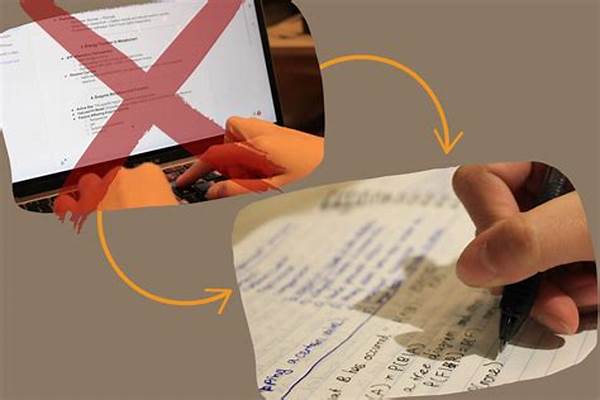In the age of smartphones, tablets, and laptops, the art of handwriting seems almost forgotten. However, many students, professionals, and creatives are discovering that handwritten notes offer a unique advantage over their digital counterparts. This isn’t just about nostalgia or the romantic notion of a quill on parchment. There’s a deep-rooted psychological and educational benefit tied into the act of writing things down by hand. For centuries, handwritten notes have been the cornerstone of learning, capturing thoughts, and immortalizing ideas. But why, in our ultra-digital world, do they still hold sway over the pixel-led screens?
Read More : The Science Behind Effective Study Breaks
One could argue it’s about attention. The very act of writing by hand forces you to slow down. As your hand carefully crafts each letter, there’s an unparalleled connection between your mind and the material. According to several studies, this physical engagement drastically improves comprehension and retention. A lesson in physics jotted down in haste on a screen might blur into the web’s chaotic cacophony. In contrast, writing it down by hand embeds it in memory, emphasizing important parts and creating a unique visual map of information.
Moreover, in a world flooded with distractions, handwritten notes offer an oasis of focus. Remember that time when you were typing notes on your laptop, and the irresistible urge to “quickly” check your social media notifications broke your flow? Handwriting eliminates that. More than just practical, it’s therapeutic. Pushing a pen across a page feels freeing and lessens the cognitive load, allowing ideas to flow naturally without the relentless interruptions digital devices bring.
Handwritten Notes: The Cognitive Edge
Perhaps one of the inherent advantages of handwritten notes is their capacity to foster deeper cognitive engagement. As famed educator Maria Montessori advocated, “The hand is the chief teacher of the brain.” Handwriting sparks brain activity, igniting neurosynaptic connections that simply don’t fire when typing. This alone is why handwritten notes beat digital notes.
—-
Objectives of Handwritten Note-taking
In the hustle and bustle of modern life, why handwritten notes beat digital notes emerges as not just a headline, but a reminder. A pivotal aspect of understanding this is through exploring the objectives behind handwritten note-taking.
First, handwritten notes offer a platform for creativity. The blank page beckons with possibilities, allowing for diagrams, sketches, doodles, and mind maps. Unlike digital notes, confined to rigid fonts and limited layouts, your handwritten canvas is as boundless as your imagination. Embracing this can transform mundane information into a personal masterpiece of understanding.
Second, the tangible experience of holding a pen and feeling the paper beneath your fingertips brings a sense of presence to learning that digital devices simply can’t replicate. The absence of glowing screens focuses our energy, fostering a deep-seated connection to the content. This tactile pleasure from handwriting results in greater mental involvement, leading to improved recall.
Third, consider the emotional aspect. Writing by hand represents more than just the transcription of information; it’s a personal expression. It might be a personal letter, journal entry, or even a grocery list—these notes become relics of ourselves, representing our thoughts and feelings captured in the moment.
A Different Kind of Engagement
Moreover, handwritten notes force us to distill information. Unlike typing, where one might transcribe verbatim, writing by hand necessitates summarization, understanding, and clarity—hallmarks of effective note-taking. As a result, this strengthens learning outcomes and ensures critical points aren’t lost in translation.
By incorporating studies and research, we find that handwritten notes remain unrivaled in certain educational contexts. One famous study from Princeton University found students who took notes by hand consistently outperformed peers who typed their notes, especially when it came to understanding complex concepts. It’s not merely about recording words but engaging deeply with the subject matter.
—
The Story of Revival
The origins of handwritten notes harken back to times when monks meticulously copied manuscripts, preserving human wisdom through patience and precision. Today, this careful diligence finds relevance in various modern vocations. Professors advocating handwritten lectures, novelists drafting stories in battered notebooks, and designers sketching prototypes testify to its timeless utility.
—
Why Handwritten Notes Excite the Educational Sphere
The renaissance of handwriting is not just limited to personal growth. Educational institutions are seeing the benefits and reviving traditional writing exercises. Polls indicate students feel less anxious and more prepared in environments promoting handwritten exams over computer-based formats. It stems from familiarity—a comforting echo of days when thoughts naturally flowed from mind to paper.
Whether you’re an advocate for why handwritten notes beat digital notes or a curious beginner, understanding its profound effects can redefine your learning, focus, and creativity.
In summary, the fusion of art and science makes handwriting an enriching paradox. In an incessantly modernizing world, where digital reigns supreme, the art of handwritten notes is a gentle reminder of the familiar comfort of ink on paper.
—
Why Handwritten Notes Excel: Real-Life Applications
While we’ve explored the theoretical benefits, real-life examples crystallize why handwritten notes beat digital notes. Here are five specific instances:
- Personal Reflection: Journaling invites introspective thoughts, allowing for deeper self-awareness and emotional release, more effectively than digital diaries.
- Creative Brainstorming: When mind mapping or storyboarding, drawing freely on paper surpasses the limits of specific apps—highlighting fluid thought processes only a pen can facilitate.
- Studying & Memory: Students often comprehend complex topics like calculus or historic timelines better with handwritten synthesis and summaries.
- Meeting Productivity: Professionals find handwritten minutes and annotations in meetings spark engagement and critical analysis away from potential distractions laptops offer.
- Artistic Expression: Artists and designers frequently find the design process liberating with sketches, making ideas tangible in a way design software cannot.
Engaging in Discussions
Let’s delve into the lively discourse surrounding why handwritten notes beat digital notes. In an era where technology is king, could the pen truly be mightier than the keyboard?
Many argue that technology is a tool for efficiency, allowing faster information capture and sharing. Yet, efficiency doesn’t always equate to effectiveness. The intimate act of handwriting, they claim, fosters a more personal relationship with content, nurturing a sense of ownership over ideas.
Opponents, however, point to the practicality of digital note-taking, with cloud storage and search functionalities making life infinitely simpler. Yet they often miss the nuance: while digital is efficient, handwritten notes resonate on a personal level, offering a richer learning experience.
Interestingly, in our “all-online-all-the-time” world, there’s an ironic twist. People crave authenticity and connection—and in note-taking, handwritten methods deliver this. They provide a tactile, grounding counterbalance to the impersonality of digital screens.
In the spirit of open conversation, let’s entertain the possibility that a harmonious blend of both could be the answer. While technology drives ambition, tradition deepens understanding. Incorporating both types of note-taking could marry the best of both worlds.
—
Embracing Handwriting: A Call to Action
Finally, recognizing why handwritten notes beat digital notes prompts a collective reevaluation of our educational and professional toolkits.
To truly experience the benefits, practitioners must proactively integrate handwriting into their routines. While digital tools cater to immediacy, carrying a notebook complements these tools by offering a personal archive of growth and discovery.
One pivotal moment can often define a realization. Imagine an exam scene: the silence disrupted only by the sound of pen gliding over paper, a student’s face alive with concentration—a testament to focused, purposeful learning.
And when we write with our hands, we’re not just communicating; we’re preserving an art that has shaped the contours of civilization. Let’s think of the sustained discipline demanded by handwriting as not a hindrance but a chance. A chance to slow down, marvel in finesse, and connect deeply with our innermost thoughts.
In tapping back into this timeless practice—this art and science—both personal and professional endeavors take on a new depth and clarity, reminding us why handwritten notes persistently beat digital notes.
—
Further Insights into the Power of Handwritten Notes
—
Descriptive Interpretations
Keeping pace with rapid technological advances might seem essential, but in the serene act of handwriting, there’s a respite—a retreat, holding immense promise. Our conversation today stems from a deep-rooted curiosity: why handwritten notes beat digital notes? This isn’t simply about resisting technological progress. Instead, it’s about wisdom, recognizing the place and power of tradition alongside innovation.
Science and history testify to the handwriting’s influence. As observed, numerous studies underscore the role of written notes in effective learning, emphasizing an intimate relationship developed through this practice. Yet, the debate continues. Advocates of digitization tout its undeniable benefits—speed, convenience, accessibility—even trying to surpass the gains offered by manual writing.
On a more emotional plane, the handwritten word serves as a tangible legacy. It’s a reflection of personal style and soul, bearing testimonies to moments in time. Like the heartbeat, handwriting is unique to the individual, and within its folds lies the potency to ignite inspiration and innovation.
As digital waves threaten to engulf every facet of our existence, how do we ensure the art of handwriting maintains its rightful place? Encouragement and widespread acknowledgment of its benefits could pave the way for balanced co-existence. Just as our grandparents inked their wisdom onto paper, today’s generation could embrace the dual comfort of keyboards and quills.
—
Short Article: Handwriting in Modern Context
In today’s digital age, when keyboards rule over pens, the value proposition of handwritten notes merits a closer look. So, why handwritten notes beat digital notes?
By their very nature, handwriting notes invite mindfulness and engagement. Whether you’re a student absorbing lecture material or a professional sketching a workflow, the flowing ink guides focus inward, fostering a direct link to material absorption. Acknowledged widely among educators, the hand-brain connection expands cognitive capabilities, encouraging proactive learning.
The Multidimensional Appeal
Handwritten notes support creativity beyond limits imposed by fonts and apps. Whether it’s the quirky production of diagrams or doodling to break monotony, handwriting transcends its functional purpose.
Moreover, therapists note that jotting thoughts on paper offers an unrivaled emotional release. It’s a dialogue between the conscious and subconscious—a therapeutic tool silently awaiting recognition amidst the digital clamor.
Balancing Old and New
While digital platforms seamlessly accommodate collaboration and sharing, handwritten notes stand firm as reflective and deeply personal. Marrying both paradoxes becomes a rewarding strategy—a modern-day philosopher’s stone converting insights to actions.
Consider engaging methods combining both approaches. Upload handwritten musings to likewise digital repositories or merge paper and cloud to benefit from the strengths of each.
In conclusion, why handwritten notes beat digital notes lies in their unparalleled ability to engage, emote, and entrench. Embracing handwriting grants access to inner creativity and focus—turn to it whenever clarity beckons, and you’re bound to unravel unparalleled potential.


